

Organ : 2 keyboards , pedalboard - 23 stops
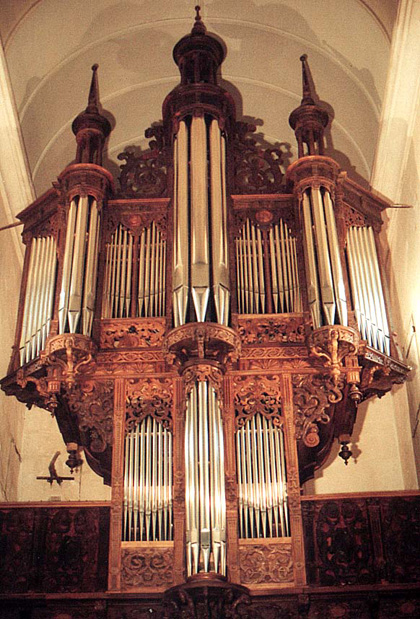
Very few pieces of archives concern this instrument. Could an organ exist in the XVIth century? We notice that if the building was built in the XIIth century, its bell tower was redone in the XIXth century.
The organ is situated behind the facade, in the bottom of the nave.
Composition :
| Positif | Grand-Orgue | Pédale |
| Bourdon 8' | Bourdon 8' | Flûte 8' |
| Prestant 4' | Montre 8' | Trompette 8' |
| Flûte allemande 4' | Prestant 4' | |
| Doublette 2' | Flûte 4' | |
| Larigot 1 1/3' | Nazard 3' | |
| Cymbale | Doublette 2' | |
| Cromorne 8' | Quarte de Nazard 2' | |
| Voix humaine 8' | Tierce 1 3/5' | |
| Flageolet 1 | ||
| Fourniture III rgs | ||
| Cymbale III rgs | ||
| Cornet V rgs | ||
| Trompette 8' |
Shift coupler : I/IIDiapason 440
Pedalcoupler GO meantone temperament
Tremulant
Several notes regarding an organ or some organists exist in the account books of the Priory :
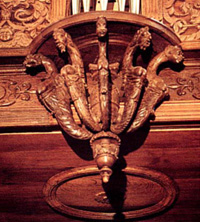 At the beginning of our restoration's works, we had in charge an organ case of the "Renaissance" heavily degraded : Great-Organ and Positive (only one front face), an instrumental material composed of a windchest of 22 registers with two wind boxes and inserted channels, and some elements of mechanical action : an Italian-style rollerframe, a board of a French-style pedalboard, some sticks of stop actions. All this material was in a neglected state and in a very advanced state of decomposition due to the high humidity inside the church.
At the beginning of our restoration's works, we had in charge an organ case of the "Renaissance" heavily degraded : Great-Organ and Positive (only one front face), an instrumental material composed of a windchest of 22 registers with two wind boxes and inserted channels, and some elements of mechanical action : an Italian-style rollerframe, a board of a French-style pedalboard, some sticks of stop actions. All this material was in a neglected state and in a very advanced state of decomposition due to the high humidity inside the church.
We noted two places for the keyboards. One behind the big case, the other one in the front. That of the back seemed much more older.
The lower case was made of big boards of oak, boorishly cut to form the built-in console .
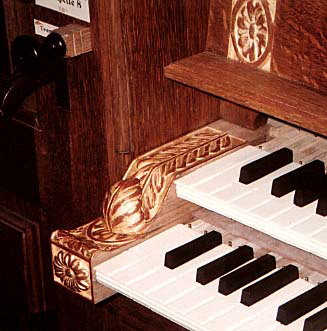
After dismantling of the cases, and once these boards of oak were taken off, we were able to examine the structure of origin and to notice the modifications which were brought to it. Old mortises associated with several other tracks of assemblies indicated us clearly that the front face of the
positive had been removed from the big case.
We indeed could deduct logically, that originally, the organ was situated at the edge of the gallery, and that the case of the Great-Organ was originally built with the facade of the positive at the level of the lower case, what explained that the built-in console was situated in the back.
The complete reconstruction of this magnificent case from the "Renaissance", according to our proposal was accepted by the Regional Preservation of Historic monuments, including the restoration of the gallery. The instrumental parts (probably of the beginning 19th century) couldn't, therefore, be kept. Their very advanced state of degradation anyway made difficult, even impossible, their restoration. They have been however preserved so that one day, they could be possibly exposed in the church.
The gallery : (extract of a study made by M. Decavèle, technician of the Historical Monuments)
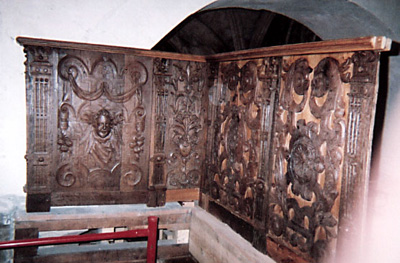
«The gallery is as high as the abacus of the capitals of the Romanic pillars which separate the nave of both sides. It presents three carpentered faces and a decorated coffered ceiling taking supports, on its sides, on drums with consoles. The balustrade in oak consists of sculptured panels fitted in posts with fluted pilasters, which remind clearly those of the positive's facade's posts.
The decoration of these panels represents geometrical compositions of interlacing and stylized foliages, with, in the center, some roses, others on sides, with overhanging of drapery and some angels' heads in the center. In the connecting of angles, shortened panels representing vases with lily flowers, still in the style "Renaissance "»
«… The balustrade leans on a double entablature decorated with strong mouldings . The top in overhang lies on consoles, or corbels, adorned with leaves of acanthus, alternated in front with cartridges boxes of foliage with lily flowers.
" We can see in this gallery an ancient rood screen, some people think of the St Maclou's ancient rood screen, in Rouen »
The case :
Entirely in oak, it includes three turrets in facade, the biggest, of 8 feet, is in the center, and two pointer turrets aside, the face of which was furnished with pipes, that of the back being closed by a panelling. The facade of the positive includes a central turret with 7 pipes and 2 side flats of each 9 pipes.
The turret of the positive fits under the big turret of the Great organ explaining the important bottom in pendant with its 5 little consoles with human faces.
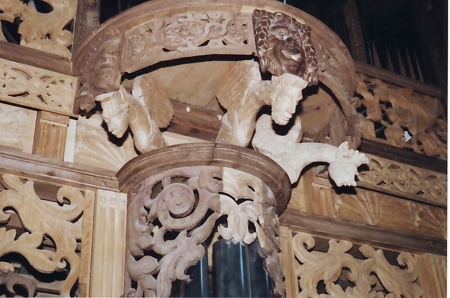
"The decoration in general, allows to date the first construction of this case in the very first years of the XVIIth century, at the time of Henri IV or the Regency of Marie de Medicis. The constituent elements remind at the same time the last period of the "Renaissance" and the first quarter of the 17th century. We can make links with other cases of the beginning of the XVIIth, perfectly dated, such those of Rodez, of Air-sur-la-lys, Carcassonne, either with Norman cases such those of Veules, Neville, Eu, Vernon for the use of pointed towers.
Other elements of the decoration evoke the previous century, such as "landernaux" and turrets' pinnacles, posts' pilasters with composed motives, pendants with ball, doors with decoration, planes of draught-boards and portico, banners of the wind boxes and those, lower and upper, of the round and pointed turrets , rhythms of geometrical friezes with interlacings and roses, corbels covered with sober foliage or pleasant feminine face or male contorted face. Finally, a whole fantastic world of fancies appears on the small consoles of the pointed turrets: winged horses, harpies with old men's head, dragons.
All this decoration, sensibly composed, enriches the organ case without weighing down it, and participates in its dynamism, at the same time by its diversity and its repetitions."
The new instrumental part:
The choice was made to get closer as much as possible to the organs' composition at the time of Titelouze.
Keyboards retook their place in the back, place which they had originally. The posts behind the case, framing the built-in console were, from the start, full of square holes for the passage of the stops' levers, the new drawstops use these one and the number of holes fixed the number of stops.
The windchest of the Great-Organ follows the prescription of the facade, it's the same for that of the Positive placed in front of the keyboards in the lower case. Two small pedals' windchests, situated in the extremities and behind the two side pointed turrets, contain the Trumpet 8 and the Flute 8. A part of this Flute 8 composes the facade. The rest is the Montre 8 and the Prestant 4 for the positive.
The key action is simply suspended for the Great-Organ with a rollerframe of Italian style, what allows a reduced dimensions in height. That of the positive is a sticker action with a backfall under the windchest. Rollerframes called "Italian" are simple bars of round iron of a diameter which can go from 4mm to 6mm. The extremities are angled and forged in pallet shape. Loops in brass fxed in the panel and blocked at the bottom of it, act as a degree for the rotation of the roller.
This system is very simple and of a perfect efficiency, the number of loops is determined by the length of the roller, the flexion is thus completely avoided. If it is well realized, the functioning is outstandingly silent. It is in Italy where this type of technique was especially developed, but it is not rare to meet it in the French organ (Clicquot for the extension rollerframes of the positive, Borme and Gazeau in Eyguières on 1803).
The stop action is realized entirely wrought iron, the minimum dimensions of this one allow an easier access to the internal pipes of the Positive in the lower case. Behind the keyboards is arranged a skeleton which receives two cuneiform bellows of 6 x 3 feet.
For all the pipework, in particular for the determination of their sizes, we approached to what we know of the pipes' specificities in the 17th century (Juvigny, Montauban, Embrun,...), too rare and too incomplete pipes in France to have irrefutable information. To go back in time before this period has, in our opinion, not many sense today. The new sound material of this organ is thus an interpretation, based on technical observations and their musical implications of the period of Titelouze. The tuning was made according to a mean-tone temperament with 8 pure tierces.
vidéos: